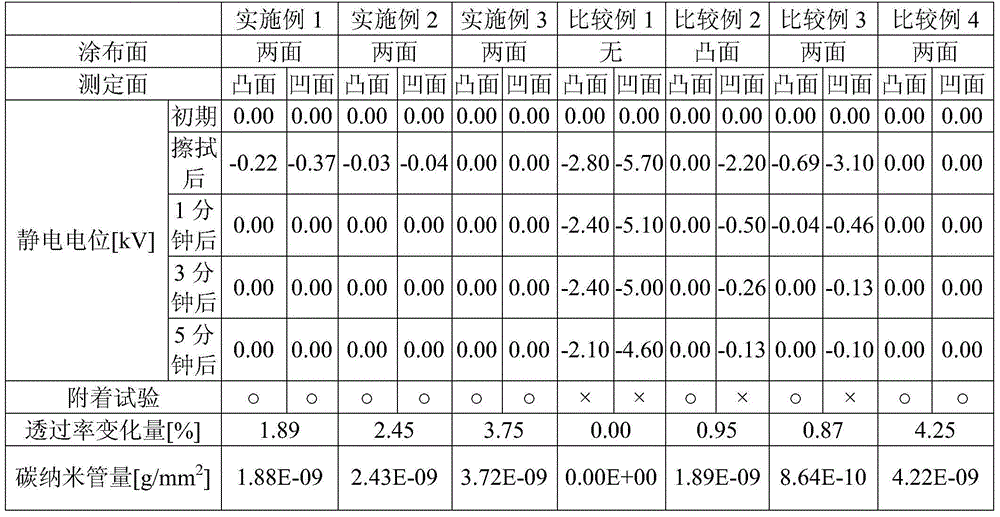Optical product and plastic lens for eyeglass
A technology for optical products and plastic lenses, applied in glasses/goggles, optics, nano-optics, etc., can solve problems such as ease of operation, and achieve the effects of maintaining durability, not affecting transparency, and excellent antistatic properties
- Summary
- Abstract
- Description
- Claims
- Application Information
AI Technical Summary
Problems solved by technology
Method used
Image
Examples
Embodiment
[0032] Next, Examples and Comparative Examples of the present invention are given. However, these examples do not limit the scope of the present invention.
[0033] (transmittance change amount and carbon nanotube amount per unit area)
[0034] The carbon nanotube dispersion liquid is uniformly applied to one surface of the lens substrate 1 so that the dispersion liquid does not scatter, and dried to form the carbon nanotube accumulation layer 2, and the transmittance of the obtained object is obtained. The amount of change and the amount of carbon nanotubes per unit area to get their correlation. For example, on the lens substrate 1 of a spectacle lens with a diameter of 75mm, 0.25ml (milliliters) of 0.0128wt% (weight percentage) carbon nanotube ethanol dispersion is dropped, and when coated as above, the amount of change in transmittance 0.7%, the amount of carbon nanotubes per unit area is 1.39E-9g / mm 2 . It should be noted that the lens (optical product) before the fil...
Embodiment 2
[0040] In Example 2, evaluation was performed on performance changes after being left for 7 days in an environment of 60 degrees Celsius (the same applies hereinafter) and 95% of the environment.
[0041] (Formation of carbon nanotube stacked layer)
[0042] The carbon nanotube stacked layer 2 was formed using a spin coater. A carbon nanotube ethanol dispersion (manufactured by MeijoNanoCarbon Co., Ltd., 0.0128wt%) was dropped onto the spectacle lens, rotated at a rotation speed of 1000 rpm for 30 seconds, and dried at 60°C for 15 minutes to remove the solvent. Carbon nanotube accumulation layers 2 are formed on both surfaces of 1. In addition, the spectacle lens has the optical characteristics of a refractive index of 1.6, an Abbe number of 42, and a diopter of -2.00.
[0043] (formation of dura layer)
[0044] 206 g of ethanol, 300 g of methanol-dispersed titanium dioxide-based gel (manufactured by Nikki Catalyst Chemicals Co., Ltd., 30% solid content), 60 g of γ-glycidox...
Embodiment 1
[0048] The carbon nanotube accumulation layer, the hard coat layer, and the antireflection film are formed on both surfaces of the lens substrate 1 . In addition, the dropwise amount of the carbon nanotube dispersion liquid on each surface was set to 1.00 ml.
[0049] (Example 2)
[0050] In Example 1, the dropwise amount of the carbon nanotube dispersion liquid on each surface was set to 1.50 ml.
PUM
| Property | Measurement | Unit |
|---|---|---|
| refractive index | aaaaa | aaaaa |
| Abbe number | aaaaa | aaaaa |
Abstract
Description
Claims
Application Information
 Login to View More
Login to View More - R&D
- Intellectual Property
- Life Sciences
- Materials
- Tech Scout
- Unparalleled Data Quality
- Higher Quality Content
- 60% Fewer Hallucinations
Browse by: Latest US Patents, China's latest patents, Technical Efficacy Thesaurus, Application Domain, Technology Topic, Popular Technical Reports.
© 2025 PatSnap. All rights reserved.Legal|Privacy policy|Modern Slavery Act Transparency Statement|Sitemap|About US| Contact US: help@patsnap.com


